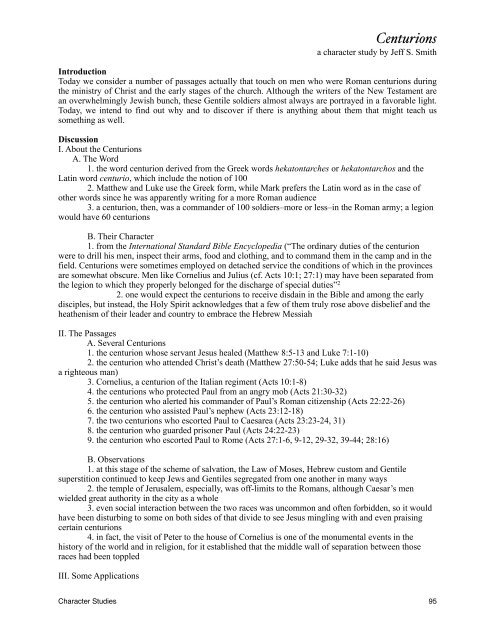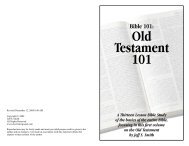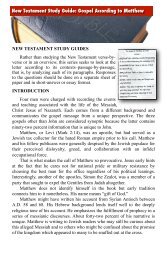Character Studies - ElectronicGospel
Character Studies - ElectronicGospel
Character Studies - ElectronicGospel
- No tags were found...
You also want an ePaper? Increase the reach of your titles
YUMPU automatically turns print PDFs into web optimized ePapers that Google loves.
Centurionsa character study by Jeff S. SmithIntroductionToday we consider a number of passages actually that touch on men who were Roman centurions duringthe ministry of Christ and the early stages of the church. Although the writers of the New Testament arean overwhelmingly Jewish bunch, these Gentile soldiers almost always are portrayed in a favorable light.Today, we intend to find out why and to discover if there is anything about them that might teach ussomething as well.DiscussionI. About the CenturionsA. The Word1. the word centurion derived from the Greek words hekatontarches or hekatontarchos and theLatin word centurio, which include the notion of 1002. Matthew and Luke use the Greek form, while Mark prefers the Latin word as in the case ofother words since he was apparently writing for a more Roman audience3. a centurion, then, was a commander of 100 soldiers–more or less–in the Roman army; a legionwould have 60 centurionsB. Their <strong>Character</strong>1. from the International Standard Bible Encyclopedia (“The ordinary duties of the centurionwere to drill his men, inspect their arms, food and clothing, and to command them in the camp and in thefield. Centurions were sometimes employed on detached service the conditions of which in the provincesare somewhat obscure. Men like Cornelius and Julius (cf. Acts 10:1; 27:1) may have been separated fromthe legion to which they properly belonged for the discharge of special duties” 22. one would expect the centurions to receive disdain in the Bible and among the earlydisciples, but instead, the Holy Spirit acknowledges that a few of them truly rose above disbelief and theheathenism of their leader and country to embrace the Hebrew MessiahII. The PassagesA. Several Centurions1. the centurion whose servant Jesus healed (Matthew 8:5-13 and Luke 7:1-10)2. the centurion who attended Christ’s death (Matthew 27:50-54; Luke adds that he said Jesus wasa righteous man)3. Cornelius, a centurion of the Italian regiment (Acts 10:1-8)4. the centurions who protected Paul from an angry mob (Acts 21:30-32)5. the centurion who alerted his commander of Paul’s Roman citizenship (Acts 22:22-26)6. the centurion who assisted Paul’s nephew (Acts 23:12-18)7. the two centurions who escorted Paul to Caesarea (Acts 23:23-24, 31)8. the centurion who guarded prisoner Paul (Acts 24:22-23)9. the centurion who escorted Paul to Rome (Acts 27:1-6, 9-12, 29-32, 39-44; 28:16)B. Observations1. at this stage of the scheme of salvation, the Law of Moses, Hebrew custom and Gentilesuperstition continued to keep Jews and Gentiles segregated from one another in many ways2. the temple of Jerusalem, especially, was off-limits to the Romans, although Caesar’s menwielded great authority in the city as a whole3. even social interaction between the two races was uncommon and often forbidden, so it wouldhave been disturbing to some on both sides of that divide to see Jesus mingling with and even praisingcertain centurions4. in fact, the visit of Peter to the house of Cornelius is one of the monumental events in thehistory of the world and in religion, for it established that the middle wall of separation between thoseraces had been toppledIII. Some Applications<strong>Character</strong> <strong>Studies</strong>! 95









